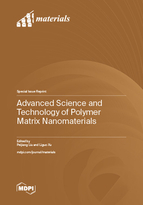Advanced Science and Technology of Polymer Matrix Nanomaterials
A special issue of Materials (ISSN 1996-1944). This special issue belongs to the section "Advanced Composites".
Deadline for manuscript submissions: closed (10 July 2023) | Viewed by 15867
Special Issue Editors
2. Reliability Physics and Application Technology of Electronic Component Key Laboratory, The Fifth Electronics Research Institute of the Ministry of Information Industry, Guangzhou 510610, China
Interests: nanomaterials; polymers; polymer matrix composites; electromagnetic wave absorption; microwave absorption; polymer brushes; advanced polymer composites; mechanical properties; templated synthesis; graphene reinforced polmyer; MXene
Special Issues, Collections and Topics in MDPI journals
2. South China Advanced Institute for Soft Matter Science and Technology, School of Molecular Science and Engineering, South China University of Technology, Guangzhou 510640, China
Interests: gel material; flexible sensor; degradable material; marine antifouling; multicomponent polymerization; aggregation-induced emission
Special Issues, Collections and Topics in MDPI journals
Special Issue Information
Dear Colleagues,
Polymeric and hybrid nanomaterials are important and versatile materials that can be tailored to overcome the current challenges in materials science. This new class of composite materials has shown enhanced optical, electrical and dielectric properties. The development of novel polymeric and hybrid nanomaterials that are able to fulfill the needs of diverse application areas with the consequent societal benefits is being applied to more specific applications. However, as the physical, chemical, and structural properties of hybrid and polymeric materials are dependent on the starting materials and on the functionalization methods in use, the characterization of these materials assumes particular relevance.
The present Special Issue aims to discuss all aspects regarding the innovation, functionalization, and characterization of polymeric and hybrid materials in their different forms (membranes, fibers, hydrogels, etc.). We welcome full articles, short communications, or review articles covering topics related to the application of polymeric and hybrid materials in the electronic, health, conservation and restoration, environment, and industrial fields. This Special Issue represents a good opportunity for researchers from different areas to present their research, to contribute to the establishment of more detailed correlations between methods, structure, and materials properties, and to highlight new challenges to achieve more efficient material performances.
Dr. Peijiang Liu
Dr. Liguo Xu
Guest Editors
Manuscript Submission Information
Manuscripts should be submitted online at www.mdpi.com by registering and logging in to this website. Once you are registered, click here to go to the submission form. Manuscripts can be submitted until the deadline. All submissions that pass pre-check are peer-reviewed. Accepted papers will be published continuously in the journal (as soon as accepted) and will be listed together on the special issue website. Research articles, review articles as well as short communications are invited. For planned papers, a title and short abstract (about 100 words) can be sent to the Editorial Office for announcement on this website.
Submitted manuscripts should not have been published previously, nor be under consideration for publication elsewhere (except conference proceedings papers). All manuscripts are thoroughly refereed through a single-blind peer-review process. A guide for authors and other relevant information for submission of manuscripts is available on the Instructions for Authors page. Materials is an international peer-reviewed open access semimonthly journal published by MDPI.
Please visit the Instructions for Authors page before submitting a manuscript. The Article Processing Charge (APC) for publication in this open access journal is 2600 CHF (Swiss Francs). Submitted papers should be well formatted and use good English. Authors may use MDPI's English editing service prior to publication or during author revisions.
Keywords
- polymer
- nanomaterial
- hybrid material
- gel material
- mechanical property
- aggregation-induced emission
- electromagnetic wave absorbers
- microwave absorbers
- degradable material
- multicomponent polymerization








